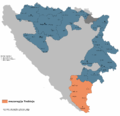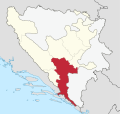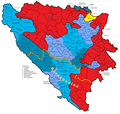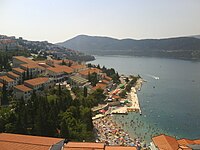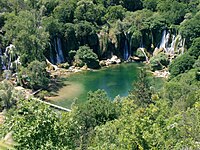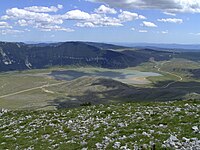Herzegovina
This article needs additional citations for verification. (August 2021) |
Herzegovina
Hercegovina Херцеговина | |
|---|---|
UTC+2 (CEST ) |
Herzegovina (
Bosnia, the larger of the two regions, lies to the north of Herzegovina; the
Etymology
The Ottomans were the first to officially use the name Hercegovina (English: Herzegovina;
The title herceg is a Slavic form of German
The name Herzegovina is the most important and indelible part of Herceg Stjepan's legacy, unique within the entire Serbo-Croatian speaking world of the Balkans, of one medieval person giving his name, or more precisely his noble title, which in the last few years of his life became literally inseparable from his name, to an entire region previously called Humska zemlja, or Hum for short,[7] which still exists today in the name of Bosnia and Herzegovina.[2][6]
However, this is just a superficial understanding, and cannot be attributed to Herceg-Stjepan alone, as his title was not of decisive importance after all.
While under
History
History of Herzegovina |
|---|
|
|
|
Medieval period
Ottoman period


In 1482, the lands of Stefan Vukčić's successors were occupied by Ottoman forces. The Ottomans were the first to begin officially using the name Herzegovina (Hersek) for the region.
The Bosnian
During the
The
As a result of the
As a result of the
The new joint entity was after 1853 commonly referred to as Bosnia and Herzegovina. Serbs in the region
The Herzegovinian Serbs frequently rose up against the Ottoman rule; culminating in the
Montenegro did succeed in liberating and annexing large parts of Herzegovina before the
Modern history
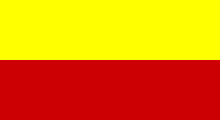
As a result of the
The historical Herzegovina region in the Principality of Montenegro was known as East or Old Herzegovina. The Serb population of Herzegovina and Bosnia hoped for annexation to Serbia and Montenegro. The Franciscan order opened the first university in Herzegovina in 1895 in Mostar.
In 1908, Austria-Hungary annexed the province, leading to the
During
In 1918, Herzegovina became a part of the newly formed
Geography
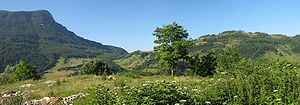
Herzegovina is a southern region of Bosnia and Herzegovina. Its borders and territory have never been strictly defined, be it geographically or culturally, nor has there ever been a geopolitical and economic subdivision of Bosnia and Herzegovina bearing the name.
The larger of two Bosnia and Herzegovina regions, Bosnia, is to the west and north of Herzegovina, and the border between two regions, Herzegovina and Bosnia, is unclear as it has never been strictly defined. To the south-southwest of region lies Croatian region of Dalmatia, and to the east-southeast is Montenegro.
The land area is c. 11,500 km2 (4,400 sq mi),[13] or around 23% of the total area of the present-day Bosnia and Herzegovina, to c. 12,300 km2 (4,700 sq mi), or around 24% of the country.[1]
It borders the Adriatic Sea along its 20 km (12 mi) coastline.

The terrain of Herzegovina is mostly hilly karst with high mountains in the north such as Čvrsnica and Prenj, except for the central valley of the river Neretva. The upper reaches of the River Neretva lie in northern Herzegovina, a heavily forested area with fast-flowing rivers and high mountains. Konjic and Jablanica lie in this area.
The Neretva rises on Lebršnik Mountain, close to the
Cities and towns
The largest city is Mostar, in the center of the region. Other larger towns include Trebinje, Stolac, Široki Brijeg, Posušje, Ljubuški, Tomislavgrad, Grude, Konjic, and Čapljina.[1]
Mostar is the best-known urban area and the unofficial capital. It is the only city with over 100,000 citizens. There are no other large cities in Herzegovina, though some have illustrious histories.[1]
Administration
In the modern state of Bosnia and Herzegovina, Herzegovina is divided between the countries' two major entities, Republika Srpska and the Federation of Bosnia and Herzegovina. Republika Srpska's part of Herzegovina, commonly referred to as East Herzegovina, or increasingly more often "Trebinje Region", is administratively divided into municipalities of Berkovići, Bileća, Gacko, Istočni Mostar, Ljubinje, Nevesinje, and Trebinje.[1]
Within the Federation of Bosnia and Herzegovina, Herzegovina is administratively divided between the cantons of Herzegovina-Neretva and West Herzegovina; the two cantons only make mention of the region in relation to other locations or geographical features. Part of the region belongs to Canton 10.[1]
-
East Herzegovina or "Trebinje Region" in Republika Srpska
-
Economic region of Herzegovina, planned since 2013.
Population
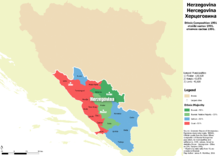
The locals of Herzegovina are known by the demonym Herzegovinians (Bosnian: Hercegovci / Херцеговци; singular masculine: Hercegovac / Херцеговац, feminine: Hercegovka / Херцеговка). While the population of Herzegovina throughout history has been ethnically mixed, the Bosnian War in the 1990s resulted in mass ethnic cleansing and large-scale displacement of peoples. The last pre-war census in 1991 recorded a population of 437,095 inhabitants.
- Ravno, and Prozor-Rama.
- Bosniaks mainly live in the areas along the Neretva, such as Mostar, Konjic and Jablanica, to a significant extent in Stolac, Čapljina, Prozor-Rama, and to a lesser extent in Nevesinje, Gacko, Trebinje.
- Serbs are the majority in East Herzegovina, including the municipalities of Berkovići, Bileća, Gacko, Istočni Mostar, Ljubinje, Nevesinje, and Trebinje.
The demographic makeup of West Herzegovina Canton, Herzegovina-Neretva Canton and East Herzegovina according to the 2013 census is:
| Ethnic Composition[15] | ||
|---|---|---|
| Ethnic Group | Number | Percentage |
| Croats | 212,428 | 55.2% |
| Bosniaks | 94,895 | 24.7% |
| Serbs | 70,952 | 18.4% |
| Others | 6,483 | 1.7% |
| Total | 384,743 | 100% |
Culture
Monuments
The region has rich history and diverse culture, with variety of important monuments of cultural-historical heritage, such as the following cultural monuments;
Religion
The Constitution of Bosnia and Herzegovina guarantees freedom of religion,[16]
- Eparchy of Zahumlje and Herzegovina of the Serbian Orthodox Church
- Roman Catholic Diocese of Mostar-Duvno and Roman Catholic Diocese of Trebinje-Mrkan
- Islamic Community of Bosnia and Herzegovina)
Music
-
Eastern Herzegovina
-
Folk costumes of Croatian women from Tomislavgrad Hercegovina.
Tourism
In 2013, tourist cluster Herzegovina was established since Herzegovina didn't have a regional tourist organisation.
Herzegovina's natural landmarks include many features.[1]
- The falls of Kravica, on the Trebižat river, consist of several waterfalls near the city of Ljubuški and a popular spot for the local people to take a bath in the hot weather.
- The Hutovo Blato is a bird reserve, one of the most important in Europe and a gathering place for many international ornithologists.
- Ravnomunicipality. The cave has not been explored totally yet, but it is open to visitors. A large number of endemic cave-dwelling species have been discovered there, and new ones can be expected to be discovered still.
- Buna River, inside a cave system.
- Neum at the Adriatic Sea, Bosnia and Herzegovina's only coastal town, is also a tourist destination.
- Međugorjehas one of the most visited sites in Bosnia and Herzegovina.
Image gallery
-
Počitelj
-
Kravice Waterfalls
-
Blagaj Tekija
-
Blidinje Nature Park
-
Bileća Lake
-
Ramsko Lake
References
- ^ a b c d e f g h i j "3. Hercegovačka regija". Regionalna strategija ekonomskog razvoja Hercegovine (pdf / html) (in Serbo-Croatian). Bosna i Hercegovina. November 2004. Retrieved 22 November 2020.
{{cite book}}:|website=ignored (help)CS1 maint: location missing publisher (link) - ^ a b c Vego 1982, p. 48.
- ^ Ćirković, Sima M. (1964). "Chepter 7: Slom Bosanske države; Part 3: Pad Bosne". Istorija srednjovekovne bosanske države (in Serbian). Serbian Literary Guild. pp. starting with 336. Retrieved 21 March 2021.
- ISBN 0932885128, p. 11
- , 2012.
- ^ a b c d Ćirković 1964a, p. 272.
- ^ a b Vego 1982, p. 48: "Tako se pojam Humska zemlja postepeno gubi da ustupi mjesto novom imenu zemlje hercega Stjepana — Hercegovini."
- ^ "Borak (Han-stjenički plateau) necropolis with stećak tombstones in the village of Burati, the historic site". Commission to preserve national monuments (in Bosnian). Retrieved 2 February 2019.
- ^ Maslo, Amer. "M.A. Thesis: "Slavni i velmožni gospodin knez Pavle Radinović" (available for download at faculty website)" (PDF). www.ff.unsa.ba (in Bosnian). Faculty of Philosophy of University of Sarajevo – History Department. Retrieved 2 February 2019.
- ISBN 0631204717
- ISBN 953-6045-03-6
- ^ Lampe 2000, p. 109
- ISSN 0350-6517.
- ^ Ethnic composition of Bosnia-Herzegovina population, by municipalities and settlements, 1991. Vol. Bilten no.234. Sarajevo: Zavod za statistiku Bosne i Hercegovine. 1991.
- ^ "Popis 2013 u BiH". www.statistika.ba. Retrieved 2023-05-14.
- ^ "Freedom of religion Law..., Official Gazette of B&H 5/04". Mpr.gov.ba. Archived from the original (PDF) on 29 December 2016. Retrieved 4 January 2018.
- ^ a b "Herzegovina more and more attractive to guests and tourism investments". croatiaweek.com. Croatia Week. 8 October 2023. Retrieved 9 October 2023.
Bibliography
- ISBN 9782911527104.
- Ćirković, Sima (1964a). Herceg Stefan Vukčić-Kosača i njegovo doba (in Serbian). Naučno delo SANU.
- Ćirković, Sima (1964). Историја средњовековне босанске државе (in Serbian). Serbian Literary Guild.
- ISBN 9781405142915.
- Curta, Florin (2006). Southeastern Europe in the Middle Ages, 500–1250. Cambridge: Cambridge University Press.
- ISBN 0472081497.
- ISBN 0472082604.
- ISBN 9788639901042.
- ISBN 978-0-521-77401-7.
- Vego, Marko (1982). Postanak srednjovjekovne bosanske države (in Croatian). Svjetlost.

